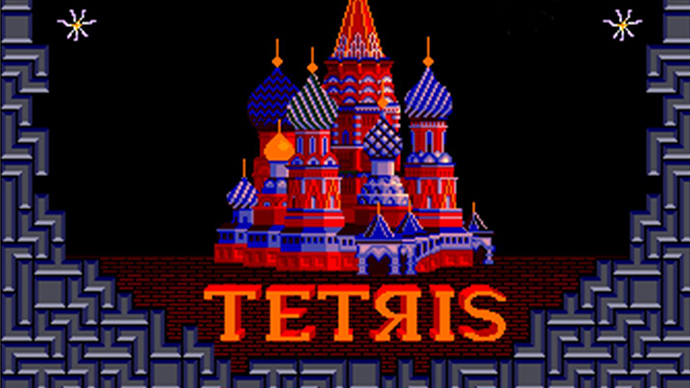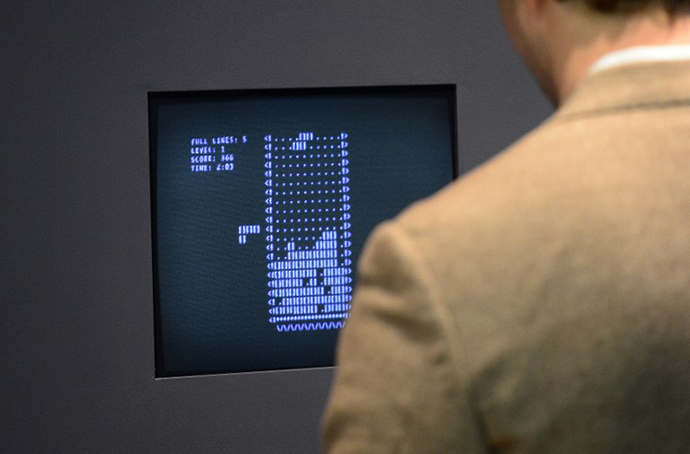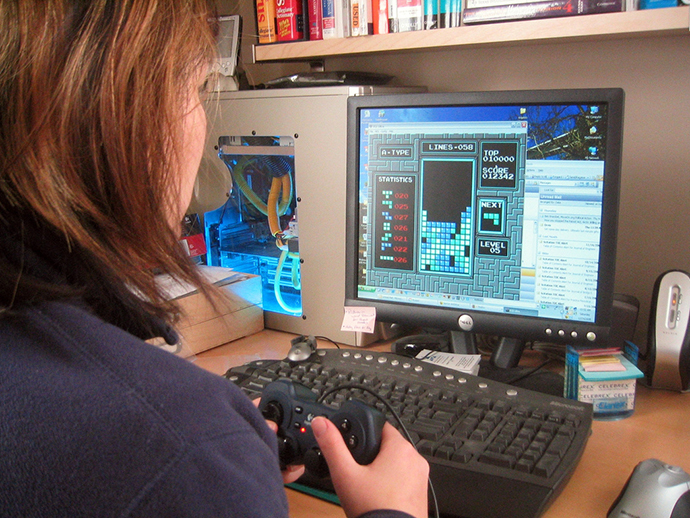Record-breaking ‘Soviet Mind Game’ Tetris turns 30

The block-stacking game was first played in a fusty Soviet lab on June 6, 1984, went on to sell at least 150 million copies – more than any other game in history – and continues to elicit fascination from ordinary players and psychologists.
Ironically, the Tetris creator lived in a country where there were almost no personal computers thirty years ago. But luckily, the 28-year-old Aleksey Pazhitnov was one of a few thousand Soviet citizens with access to one while working in a computer laboratory and charged with testing new hardware.

Taking advantage of his remit, Pazhitnov collected metrics on the imported systems by running self-programmed games on them.
Tetris became the most famous of them.
The idea did not come out of nowhere. Hard it is to imagine now that millions people would find it interesting to play with a static proto-Tetris made with physical pieces, in post-war USSR, pentominos – arrangements of five blocks – was a popular game. You could either solve a puzzle, placing the pieces carefully around a complex pattern, or challenge a human opponent, seeing who can complete a board first, taking turns.

Pazhitnov simplified the pentomino to four blocks – a tetromino – and thus Tetris (and not Pentris) was born.
“The Electronika 60, the Russian computer I originally wrote Tetris for, didn't have proper graphics, just a monitor that could display text, so I used letters to form the playing pieces,” explained Pazhitnov to the Guardian ahead of the anniversary.
“Next I put together the procedures for manipulating the pieces: pick a tile, flip it, rotate it. But the playfield filled up in 20 seconds flat. Also, once you'd filled a line, it was kind of dead, so why keep it on the screen? So I made each full line disappear, which was key. I was a pretty good programmer and it took me about three weeks to get something controllable on screen. I pretended I was debugging my program, but in truth I just couldn't stop playing it. When other people tried it, they couldn't, either. It was so abstract – that was its great quality. It appealed to everybody.”
After first reaching the West in 1986, the appeal of Tetris to a wide audience was immediately grasped. How to legally obtain a license for it from a country that had never previously exported a computer game was more difficult.
The following years involved complex legal deals, optimistic visits to Moscow to meet with Pazhitnov and stony-faced Soviet export officials, and even rumored negotiations between media baron Robert Maxwell and Mikhail Gorbachev (though it was Nintendo that won the final rights to distribute the iconic Game Boy version).
Incidentally, it is widely reported that having sold his rights to the state in a ten-year license, Pazhitnov did not benefit from his invention until 1996.
But the world did.

In the first year of being released, 1988, it topped the worldwide bestseller charts by a wide margin. Not just addictive, it was also easy to market as “THE SOVIET MIND GAME” – challenging, mysterious, vaguely sinister, and atop the Perestroika-driven zeitgeist. In popular versions of the game, kitschy Soviet imagery – cosmonaut Yuri Gagarin, the Kremlin, Hammer and Sickle – all framed the screen, as the Russian folk song Korobeiniki played ever faster.
In its abstractness, lack of external meaning, and the fact that it could only have worked on an electronic device, Tetris became synonymous with computer games themselves, attracting unprecedented attention from academics.
Psychologists coined the term Tetris Effect, to describe the sensation that experienced players got of moving the blocks when they were not playing, obsessively stacking tetronimos even when asleep. Later, it was identified that the phenomenon may give us insight into how we learn and remember to do things, churning them over in our sleep, and mentally rehearsing tasks.
Many more tried to understand the appeal of the best-seller, which, whatever the official figures, is likely to have been played by billions.
Of course, some things about the ubiquity of Tetris are straightforward enough.
The game is easy to pick up for casual users and comprehensible within seconds, yet cannot ever be mastered – as the blocks move faster and faster on higher levels, the challenge is infinitely difficult. Its score system and levels also chart one’s progress – important for the obsessive players. Its abstraction also means that it has no cultural boundaries.
But none of these explain why people actually play Tetris.

The consensus seems to be that it is the mainly the compulsion to restore order to the world, and the satisfaction of having done so – repeated ad infinitum.
“The main part is visual insight. You make your visual decision and it happens almost immediately. Insight means emotion: small, but many of them, every two, three seconds. The second mechanism is unfinished action. Tetris has many unfinished actions (that) force you to continue and make it very addictive. The third is automatization: In a couple of hours, the activity becomes automatic, a habit, a motivation to repeat,” said psychologist and subsequent Tetris co-developer Vladimir Pokhilko, who committed suicide after his and Pazhitnov’s company went bankrupt in the late 1990s.
As for Aleksey Pazhitnov, somewhat predictably he struggled to bottle lightning a second time, and after working on more ambitious projects, has returned to producing an ever more perfect version of Tetris.
“Tetris came along early and had a very important role in breaking down ordinary people's inhibitions in front of computers, which were scary objects to non-professionals used to pen and paper. But the fact that something so simple and beautiful could appear on screen destroyed that barrier,” said Pazhitnov.
The current generation of casual games, such as Candy Crush Saga, are direct descendants of that aim, ensnaring a new generation of people otherwise unlikely to spend four hours staring at a screen.
And while he never became a billionaire like his successors, Pazhitnov sounds anything but bitter about how things turned out.
“I didn't make much money at first, but I was happy, because my main priority was to see people enjoying my game.”













